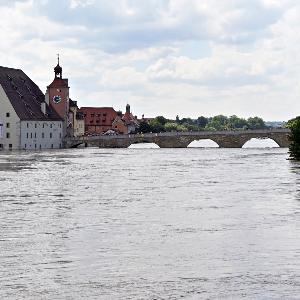“We have to adapt to new realities”
17 Jun 2024
What consequences should we draw from more frequent extreme weather and flooding events? We ask LMU geographers Matthias Garschagen and Ralf Ludwig.
17 Jun 2024
What consequences should we draw from more frequent extreme weather and flooding events? We ask LMU geographers Matthias Garschagen and Ralf Ludwig.

© picture alliance / dpa | Sven Hoppe
The current floods in Bavaria have left a trail of devastation behind them and given us another reminder that extreme weather due to climate change is become more frequent and more intense. In ongoing projects, LMU geographers Professor Matthias Garschagen and Professor Ralf Ludwig are investigating the causes, dynamics, and consequences of heavy rainfall events and floods, including in Bavaria. In our interview, they talk about the challenges of future flood risks and what measures can be taken to adapt to them.
Was the large extent of the flooding foreseeable?
Ralf Ludwig: The foreseeability of such events is naturally always a question of perspective. In this specific case, there were advance warnings to expect strong rainfall in eastern Baden-Württemberg and western Bavaria. But it’s actually difficult to predict that the rainfall would be so extreme. And so it surprises people when the event turns out to be so severe. The triggering mechanism, the so-called ‘five-b’ weather conditions, is not unknown. On the contrary, these weather conditions have always been a major contributor to the very large river flooding events of recent decades in southern Bavaria. In parts of southern Germany, the oft-cited 100-year flooding event has occurred five times over the past 25 years.
Should we expect such floods to occur in Bavaria with increasing frequency in the future?
Ludwig: In the ClimEx project, we’re investigating the causes and the dynamics of extreme events in Bavaria. In our analyses, Dr. Magdalena Mittermeier was able to show that the number of ‘five-b’ events is not significantly increasing, but that the events are becoming appreciably more intense than before and seem to be occurring earlier in the year. Against this background, we have to fundamentally reappraise how we actually want to handle the term “100-year flood.” This concept is significant, because it plays a substantial role in determining how we measure our flood defenses. And if we proceed from false premises, which we’re clearly doing at present, then our flood defenses will have the wrong dimensions.
It's important therefore that we reflect – including from a scientific perspective – on how we actually want to define hundred-year events, particularly in a world that is changing very dynamically due to global warming. What we currently define as a 100-year flood will only be a 30-year flood by the middle of the 21st century. The increased frequency of flooding, along with the higher intensity, will render such terms largely ineffective.
Against this background, we have to fundamentally reappraise how we actually want to handle the term “100-year flood”Ralf Ludwig
In which areas is adaptation to future scenarios especially difficult?
Matthias Garschagen: One of the biggest unanswered questions is how we deal with heavy precipitation and flash floods, as such events can happen anywhere. From survey data obtained in our KARE project in the Bavarian Oberland region, we know that many people say they are not concerned about flood risks in their locatoin, because they have never experienced flooding events in the past. As a result of climate change and changes in heavy precipitation and associated torrential downpours, this can be a false conclusion. In the future, cellars and ground floors could flood in places where people would currently think it’s impossible. And because it can happen anywhere, this poses a special difficulty. It’s not possible to erect defenses over such a large area, such as flood barriers at large rivers. These are certainly issues that will challenge us.
What measures are needed in Bavaria in the medium and long terms to deal with these heavy rainfall and flooding events?
Garschagen: One aspect is regional planning, where the big question is: How do we assess and designate land areas in future? Which areas could be affected by flooding in future or could be used for large-scale flood protection? This can involve things like flood retention basins or the reassessment of currently developed land.
There’s certainly work to do in Bavaria in this regard. We need much more land areas set aside for flood prevention, so that water can drain away and disperse in flood situations instead of sweeping into human settlements or precious cultural landscapes. We also need to make our land use much more multifunctional – say, as agricultural land and for flood protection – that’s critically important. This will require regulations as well, and we need to start thinking about things like compensation. In Bavaria, we’ve been rather poor at this and have played one interest off against the other. In other places, they’ve had more success. For the flood defenses on the Rhine, for example, there was a determined effort to designate large-scale flood retention basins following the major floods of the 1990s.
What can local governments do?
Garschagen: As part of the spatial planning process, local governments should think about where the water can go. Local governments could also embrace multifunctional thinking and do things like design sports pitches and playgrounds to additionally function as flood retention areas during flooding situations. Current efforts tend to be directed at keeping the water out, but in the future people will have to increasingly contend with water inside settlement areas. With respect to heavy rainfall events in particular, such measures would be more economical than alternatives such as the very expensive reconstruction of underground sewerage systems.
Another area relates to flood-proofing buildings, which is to say: the prevention measures undertaken by businesses and households. For example, are all the basement windows flood-proof? Are backflow barriers actually in place? Do houses in at-risk locations have flood barriers for doors and windows, or sheet piling?
We need much more land areas set aside for flood prevention, so that water can drain away and disperse in flood situationsMatthias Garschagen

Ralf Ludwig is Professor in Applied Physical Geography and Environmental Modeling at LMU’s Department of Geography. | © LMU
Floods cause billions of euros of damage. How can this be managed financially?
Garschagen: Compulsory insurance has long been mooted, and indeed political parties of all stripes are now calling for it. There are certain reasons why it still does not exist, but that’s the direction we have to move in nonetheless.
We also need to think about how the costs are shared. For example, adapting the sewerage system of a mid-sized municipality like Garmisch-Partenkirchen or Weilheim to such extreme rainfall events and resizing the underground infrastructure would be eye-wateringly expensive. Adapting flood barriers above ground is somewhat easier but very expensive all the same. In a time of increasingly tight municipal budgets, including in affluent Bavaria, we will not be able to sustain the protection levels we had in the past. We therefore have to consider how we can avoid flood situations through better prevention. Where municipal flood protection is no longer financially feasible or technically possible, we must increasingly think about flood-proofing buildings – including critical infrastructure such as retirement homes, nursing homes, and hospitals.
Ludwig: It’s clear that huge costs await us down the road. But it’s now sufficiently well known that they will be much higher still if we don’t act. If events such as we’re now observing occur in the future at a much denser rate and are more extreme and broader in scale, this will lead to large economic burdens. If we arm ourselves now and spend the requisite money for this purpose, this would be an important, worthwhile, and indeed critical investment in the future.
If we arm ourselves now and spend the requisite money for this purpose, this would be an important, worthwhile, and indeed critical investment in the futureRalf Ludwig
Can you already estimate which scenarios we’ll have to adapt to?
Garschagen: The planning system in Germany has already provided for flood analyses to be carried out at least for the large rivers, both for 100-year events and even more extreme events. For the regions at risk from 100-year floods, there are very strict building regulations. We don’t have this for extreme floods, and it was long said that it’s too expensive to factor all that in. Now we notice that these extreme events are possible – and are coming faster and harder than was expected. In municipalities like Garmisch-Partenkirchen – which actually have very successful flood defense practices and have invested a lot to protect themselves against 100-year floods – such extreme flood events could affect a considerable portion of the built-up area. We need to prepare ourselves for this.
The assessment bases we had in the past will no longer be valid in the future. In the past, there was the fundamental assumption that nature is stable and that with a 100-year flood as an assessment basis, you can draw a clear line between areas that are flood risk areas and those that are not. This clarity will disappear in the future.
Ludwig: We must not lose sight of the fact the extremes will increase. When you try to calculate the maximum that is physically possible, you quickly realize that you just cannot protect everything and cannot insure everything.

Professor Matthias Garschagen is Chair in Human Geography and heads the Teaching and Research Unit for Human Environment Relations at LMU’s Department of Geography. | © LMU
What consequences should be drawn from this realization?
Garschagen: We shouldn’t stop at the modeling and prediction of future scenarios, but should immediately consider what the results mean for potential actions. We should be clear about where the responsibilities lie, but we should also have reasonable expectations about what municipalities in particular can afford. For 100-year floods, we have formal maps for waterways, which are included in planning decisions and that citizens can view. For risk maps on extreme rainfall and torrential downpours, there is no standardized process. In Bavarian Oberland, we asked over 70 municipalities how they would handle detailed maps on torrential downpours and resulting flash floods. More than two-thirds of the relevant officials expressed reservations concerning the publication of such maps, because the municipality would face all kinds of demands it couldn’t afford.
In some pilot regions, for which very detailed risk maps were created and published, residents in high-risk areas had consequent difficulties obtaining insurance to cover damage caused by natural forces. Therefore, we need to factor these responsibilities and safeguards into our thinking and consider what adjustments are needed in the institutional and legal spheres, so that we can continue to raise awareness through the targeted use of scenarios in the future. These two things must go hand in hand.
Should settlements be planned differently in the future, or even scaled back?
Garschagen: We certainly won’t be able to avoid a debate about partial retreat from areas with the highest flood risk exposure, also in Germany. This is a discussion that keeps rearing its head. At the moment, our institutional setup is very poorly adapted to actually implementing such a policy. As an example, we can look at what happened on the River Ahr: There are very strong incentives there to build back on the same place, not just for emotional and cultural reasons, but also for grandfathering reasons in relation to matters like planning permission. Even worse is the principle that currently holds in insurance whereby insurers cover what was actually there before. In other words, if there were no flood defenses in a basement, then policies do not pay out for them and the people affected have to finance them out of their own money. This is an area of course in which we could change the regulatory framework. In future, we’re going to have to ask the question in many areas about what’s still worth protecting, what’s still possible to protect, and where we want to deliberately create incentives to retreat or not build back after a disaster. But to do this, we’ll have to create the legal conditions as well.
Climate change shows us very clearly that there are adaptation limits. In highly industrialized Germany, we struggle to acknowledge that we can’t adapt our way out of certain thingsMatthias Garschagen
So does adaptation have its limits?
Garschagen: Yes, and I think the current debate doesn’t do justice to this. Climate change shows us very clearly that there are adaptation limits. In highly industrialized Germany, we struggle to acknowledge that we can’t adapt our way out of certain things. There will be irrevocable losses, even here. We must adapt to new realities and consider how to handle situations like when parts of a city can no longer be rebuilt or when cultural heritage sites are lost forever. Our current laws and regulations are not geared at all to handling irreparable damage.